Cyril Lepetit – le petit – petty, minute, tiny, itsy-bitsy, minor, flimsy, piffling
You all know the feeling when after a day's march or a lengthy bike ride you stop to rest, squat to explore the ground, when suddenly a gust of wind passes through your sweaty private parts. Or in the evening, lying in a tub filled to the top you contemplate over gently rippling water surface reflecting the world around, when in the middle of nowhere, something dramatically cuts through the water; you relaxingly breathe out and say to yourself with relief: oh gosh, it was just me... and it is this what Cyril Lepetit's work is about. Ungraspability, evanescence; his work may be read as personal and direct yet universal and refined.
Formalistic, frivolous, titillating, flirty, delicate, perfectionist, softly-softly – his art might be attributed accordingly; the works of Cyril Lepetit appear nondescript, naive, jejune, a sort of bijou of contemporary art. His art is not shocking, not even controversial. The borderline between privacy and social surroundings, the artist and his audience, high and low, is very thin for Lepetit. The artist, however, breeches the very borderline masterfully, effortlessly yet humbly. His works are crystal clear, natural, and autonomous. Let us say that we have freedom when we do not need to tell others what we plan ahead of time. Half of freedom comes when we have to announce our plans ahead of time. Slavery: when others can foretell what we will do. This definition makes Cyril Lepetit an absolutely free artist, since what he is doing is about him, but above all, genuinely about us. Unbelievably simple, revealingly sensual.
Lepetit's art contains frequently the motif of getting to know, exploring, often in the form of diary notes. Sometimes they take the form of drawings, ████ ██ ██ ██ ███ █ ███ ███ █████ ████ ███████ ███ ██ ██████████, ██ ███ ████ ██ █ ███████ ████, ██ ██ ████████ ██ ███ ███████████ ██ █ █████ █████ ███ █████ ██████, (████████ ████ ███████ ███████ ██████) ███ ████████ ██ ██████ ██████ ████ ███ █████ ██████’█ ████. ███ ██████ ████ ████ ███ ███████ ███ ██████ ██████ ██ █ ████ ██ ████ ████ ████ █████ ███████ █████████ – ███ ████████ ██ █████ ███ ███████, ███ █████ ████ ████. His videos, likewise, convey equally confessional message: they deal with artist’s dealing with self-recognition in the world of endless physical desires. His video While My Hormones are Working, I Take Care of the Rest using testimonial collage footage to put forward the notion of revealing and exploring love.
The crucial moment in Lepetit’s work is his shift towards intervention; the artist is not exclusively a performer: his installations/actions/scultpures-objects/videos take into consideration its site and surroundings (also coincidental) as well as the audience – participants. The seminal role in the development of his present experience is the work entitled Respectful Infidelity: the Ceiling of Art, which is built on the artist’s cooperation with an audience. Some of them are asked to participate and later the artist portrays their imaginary genitals, lying beneath them with the canvas fixed among the participants’ legs. Preceding works, such as Help Yourselves or Bum Banger clearly manifest artist’s interventions and exploratational power and sensitivity projected onto everyday reality. The former controls the audience into literally stripping the statues (humans positioned naked in transparent tubes filled with prawn crackers. It is the consumerism, starvation or curiosity of the audience that matters. The latter installation, Bum Banger, is mere audience-aimed piece: it takes the form of a seesaw installed indoors with two special pillow-holes located above each arm. In its maximum swing the seated person’s head enters an oddly looking hole. ███ ████ ██████████ ███ █████ ███ ██████ ███ ███████████ ████ ███ “████.” ███ ███████ ███████ ██ ██ █ ███████ ██████-████████ █████ ████ ██ ███████ ██ ███ ███ ████ █ █████ ██ █████ █████. ███ ████████ ███████████ ███ █████ ████████ ██████ ████████ ████████ ███████████ ███ ████████. █████ ████████ ███ █████ █████████, ███ ████████ ██ ██████ █████████ █████ ██ █ ██████ ███████ ██ ███ ██████. ██ ███ ███ ██ ███ █████████, ████ ███ ███ █████ ██ █████, ███ ████ ███████ ███████’█ █████ ██ ███ ██████, █████ ██ ██████████ ████████████ █████ ████ ████ ███ █████, ███ █████ ████ ███ ██████ ██ ████ ██ ███████ ████ ████ █████████.
In this may be Lepetit's greatest moment: in such a discrete gesture, seemingly petit yet authentic, taunting, he constantly challenges the bony art world structure; what's more, with his process-based pieces, he sheds fresh air into tired, sweaty gallery spaces, thus proving that art may not always need solutions.
Note: late September and early October Cyril Lepetit is expected in Prague as a participant at the Transit project. www.transit.org
What do you do for a living at present?
I exhibit my work, I am a part time projectionist at the Curzon Soho cinema in London and I am sometimes a visiting lecturer at art colleges & universities.
Do you consider yourself a French artist?
Oui et non. It depends on the moment. Yes, French culture is a part of me. I was born in France, my family still lives there, as do lots of friends and people I work with, but, I always had a desire to go and discover what is beyond the horizon. I grew up in Cherbourg, Normandy. I was living on a hill with a view of the sea from my bedroom. I have many memories of looking at the sea and the ferry port, which once was a transatlantic port (early 20th century: port for immigration to America, the last stop of the Titanic). In some ways, I always dreamed of other places. It sounds so banal, but I think that it comes partially from this attraction to the horizon: something close to the empty feeling that Klein’s painting can provoke in you.
Talking about the Titanic; when I was doing my MA in 1993, I asked to go to Belfast (the city where the Titanic was built, which I did not know at that time). It was a very important experience for me, both on a human level, and in the help it gave me expressing my ideas in another language, and presenting my research to another audience and other critical eyes. I think that it helped me to discover the obvious fact that art does not limit itself to the context you normally evolve in.
Regarding my relationship with the French art world: apart from the Pont-Aven ‘holiday camps’ in Brittany, I grew up with the idea that things always happened in Paris, in the “effervescent” city where many artists at the beginning of the last century came to develop their art. A time that I always associated with the bohemian lifestyle and sexual liberation: modernity.
After graduating I lived in Paris for 3 years (1996-1999) and enjoyed this time in the city very much. I mainly enjoyed it for the multicultural aspects of Paris life, the influence of the African, Middle East and Asian communities where I was living (20th & 11th arrondissements). But I also found Paris quite traditional and rigid in some ways. The works presented in the galleries and institutions were most of the time very interesting, but mostly represented the ‘dominant’ international art scene, and there were very few galleries to support young artists. Fortunately it was the beginning of new artist run spaces like Glassbox, La Flêche d’or, La Chambre. In 1999, following the presentation of my Fakir and his Bed in the exhibition Homage a l’objet d’hard a Taiwanese curator invited me to Taiwan for a month-long residency and an exhibition. Going to Asia, I also developed a project of residency in Japan where I had some contacts. I went as soon as I found a little bit of funding and logistical support. I lived and researched there for several months and exhibited in several venues & cities, among them was the NIPAF (Tokyo, Nagoya, Nagano). When I came back I decided to move to London.
Over the last 7 years I have been living away from France. As well as opening myself to other cultures, I have been also looking back and discovering a deeper understanding of French literature and philosophy, as well as history, cinema, music and many other subjects. Living in foreign countries makes you look more carefully at the culture from where you come from. I think that there is a sort of process that helps you to bring complexity back into reality.
This would lead me to refer to my research. I like comparing being abroad to the practice of learning a new language. It comes from a need for experience, a desire to be someone else. Turning your way of thinking, your grammatical structures and established concepts upside down, the possibility of feeling free: being transformed. In this sense I feel I share some common thoughts with the artist Helen Chadwick ‘you can metamorphose according to what you explore.'
So I don’t really know where I belong anymore. I consider different places significant to my identity, even if I stayed in some of them for a very short time: it just depends on what they brought me in terms of my personal constitution.
But as I said previously I keep in contact with the French art scene. I still work with curators and critics in France (Pierre Giquel, Sylvie Froux, Arnaud Labelle-Rojoux, Gilles Forest, Pascal Pique). I recently had a significant solo show in a contemporary art center (Wharf) and my book was supported by the FRAC. So, France is still a very interesting place to develop and have my work confronted.
Finally I could say that I like my ‘republican-libertarian’ CV, where the school names are not religiously referenced. My family comes from the same small town as the writer Jules Barbey D’Aurevilly. My primary school was named after the first socialist prime minister, Leon Blüm, I went to the college Denis Diderot (State school) I failed my baccalauréat at the Lycée Jean-Francois Millet.
Do you have a crucial (most important, turning point) work?
That is probably the principle of freedom, the never-ending attempt to re-invent myself... therefore all works are crucial… because at some point there is an end to this attempt.
Where do you mostly draw your inspiration from?
In creating objects or setting up actions in contexts I’ve borrowed from reality, I create situations that I call ‘fantasised.’ They deal with the nature and complexity of desire: or in other words with sexuality. I like the word sexuality for its direct relationship to the body, the object of desire. But the essence of desire and human behavior are the focus of my thought. In my work, I aim to bring to the foreground the responsibility of the individual, as well as that of the artist, for the construction of their own mechanisms of desire. I often use durational performances and films involving the audience or public, highlighting their desires as much as my own. The notion of process, therefore, plays a central part in my work. So, I involve myself in these situations out of a concern for fairness, or perhaps simply out of a desire to bring myself closer to other individuals.
My work is nourished by the diversity of cultures I come across, and via the diverse reactions of the audience who are invited to act-react in my installations and actions. For example the Hairy Exhibitionist was developed for Asian culture, but once back in France, Canada or in the UK I developed new works (Exotism, Cousin chocolat and Fontaine chantante) inspired by the moral or social perceptions of hair, virility and foreign bodies in the context of these cultures/countries.
My reflection and research have always been influenced by a personal approach to existence, related to the people I lived and experimented with, and to the context that I evolved in. That is what I tried to make visible in my book ‘Respectful Infidelity’ and also in my film While my Hormones are Working I Take Care of the Rest.
‘I am a fragment devoid of meaning if I do not refer to other fragments’ (Georges Bataille in "Les larmes d’Eros”) is also a quotation that I have referred to many times in the context of my participative art. The actions of the audience feed my imagination and reflection. The comments on my work from the viewers, the critics and other interlocutors are important to me.
I like the idea of taking part in art history and the international or ‘global discussion’ of the art world, if there is one. Is it a pretension, a belief or simply a necessity? Or simply because: ‘I am a fragment devoid of meaning if I do not refer to other fragments’. This is also what I am trying to do with the International Exhibitionist program that I initiated in London (Curzon Soho cinema. www.international-exhibitionist.org).
My personal life, personal art practice and ‘current affairs’ have an influence on my production. The notions of innocence and naivety are also important in my work. Many of my participative works require, and play with, a certain naivety of the audience. At the beginning of my actions the public is not aware of my intentions and I use my presumed innocence and their supposed naivety to serve my aims, my ‘desires’. In my forthcoming works I would like to consider whether it could be said that the supposedly liberated image of the body is often used as an illusion of sexual freedom? The redefinition of moral values, the categorisation of sexual behavior, the isolation of those perceived to be perverse and the denial of the right to difference are becoming a political issues, and indeed part of the political agenda: the search for, or redefinition of normality. There is a demand for a return to naivety: false innocence and the choice of ignorance.
You had an exhibition at ICA. What did you show there?
I was invited to participate in the exhibition London is in Six Easy Steps: Six Curators, Six Perspectives, by Guy Brett who curated the fourth part of this series of exhibitions entitled Anywhere in the World: David Medalla’s London.
For this show, I was asked to make a life-size effigy: a representation of myself. It took the shape of a mummy lying on its side: a sort of male Olympia figure. The particularity of this figure, apart from its being made from bandages, was that it had an erection and that it was resting on the edge of a Perspex box. The Perspex box contained a cast replica of my hand with the little finger up, and two miniatures of myself related to performances I have developed over the last five years: The Fakir and his Bed and Hairy Exhibitionist.
The focus of my participation in this exhibition was the performance entitled Respectful Infidelity: the Ceiling of Art. I gave this performance on the evening of the Friday, September 9th. The piece has been developed over the last three years and I felt that an invitation to the Institute of Contemporary Arts was an appropriate context in which to give this performance, which involves doing a ceiling painting whilst lying on my back. I was also interested in the possibility of leaving some kind of trace of this particular action on the walls of the ICA.
On the card that announced my performance, I was pictured standing in front of St Paul’s Cathedral with my double. My twin and I are physically identical in the image, but we are dressed differently. One of us was dressed in a very clean and classical way, wearing black pants and a white shirt, but wearing a deep blue jacket on top: Joseph Beuys- or bullet proof-like. The other was wearing a Pakistani salwar kameez. We were holding a white canvas together. A white canvas that was going to be used for the ceiling painting at the ICA.
On the day of the performance, the first one of us, wearing his city-style pants and white shirt with the deep blue ‘Beuysian’ jacket sat down in the exhibition space with the audience and read some texts from the book 'Respectful Infidelity.' At the end of the reading the second one of us took over and moved amongst the audience offering some fruits displayed on a platter (grapes, figs, strawberries).
The exhibition space of Anywhere in the World: David Medalla’s London was saturated with colorful sculptures and large prints on the walls. The light was very low and the audience was standing and sitting among the works displayed around a square of precious fabrics placed in the center of the room. A spot-light and a garland of flowers emphasized the geometrical shape covered with a piece of red silk. This object could have been a luxurious bed or an arena (it was the arena for the wrestling match between the ghosts of Marcel Duchamp and Joseph Beuys that took place at the end of exhibition - David Medalla as M.D and Adam Nankervis as J.B.). After offering the fruits to the audience and carefully displaying my oil painting kit on the bed, I stood in my salwar kameez outfit and looked at the people around me. Even if the audience was large, the atmosphere was quiet and became even more silent with time. A white / virgin canvas in my hands, I looked at the audience in the eyes, one by one. Eventually, I felt that I made eye contact with a female person and invited her to join me on the silk square in the middle of the room. While making her feeling comfortable with the intentions I had in mind, I asked her to stand up and placed the canvas in her crotch area. Then, following exactly same process I looked for eye contact with a male person in the room and invited him to join us and stand in the same position as the woman. While standing closely in front of each other, I offered them some wine and we all clinked glasses (some wine was also poured for the audience). I then left them to talk to each other and lay down on the floor.
Lying on my back, I faced the arches that their bodies formed above me. I started applying some paint on the white canvas held by my female partner. She reacted to the contact of the brush on the canvas and searched for my eyes, to inquire what I was committing us all to. Looks and smiles were exchanged with each touch of paint. The canvas was a sensitive layer between me and the other person: I had to be responsible for my gestures. Looks and thoughts ran through the slow process of painting. Reality and fantasy became closer than ever. I felt that the idea of a possible awkward or obscene situation had totally vanished from the minds of those taking part in or witnessing the scene. With a similar surge, I moved and focused my mind from the woman to the man, alternating between them, until I completed the ‘ceiling paintings.’
What have you presented since the ICA and what are the new works you are working on at the moment?
I like coming back to the same work many times, approaching it from different angles, developing it, experimenting with new possibilities and in this way shift towards new horizons. The Ceiling of Art is one of these works that I have been developing as a series: a series of different paintings, at different times, with different relations to the models/people, the women and men I involve in the work, using different approaches and processes. I am more and more interested in the dimension this series takes on when I look at the paintings and videos created from the contexts and processes I have used to make them. I made the first painting in the former convent of St Ambrogio, in the Jewish ghetto of Rome. Since then I have made several others in Belfast, Saint Sauveur Le Viconte (France), Helsinki, Huesca (Aragon), Québec, Liverpool, ICA, London and in January 2006 in New York at The Leroy Neiman Gallery, Columbia University, for the exhibition ‘Daily Noise.’ In New York I divided the gallery space with a large white screen. One part of the room was in the shadow and the other part lit with a bright spot light. Bare feet, and hair down, dressed in my salwar kameez, I invited a young Mongolian woman and a young South American man to join me in the bright part of the gallery behind the ‘shadow screen’. I offered them two small red apples from my parents’ garden in Normandy, then lay down to paint. Our shadows reflected on the white veil that separated the room.
While our actions were projected/transcribed on the screen like shadow puppets, a sound piece I call the Mermaid Song was playing. This piece is composed of women and some men expressing themselves on the following issues: What does it mean to lure people and how do you do so? Diverting attractions towards death towards pleasure and unknown territory… What does opening your world, values, life, and body to someone else mean, or represent?
The processes and time accorded to the painting is to me as essential as the result on the canvas. It is a very important time, in which I want to leave enough space for the audience to project their thoughts onto the work. I am therefore currently working on a series of videos related to each ‘Ceiling Painting’ session. I am looking for a way to present the video in relation to the paintings. One of my ideas is to build fantasy scaffolding. Scaffolding was at the center of my Ceiling of Art performance in Helsinki. Using scaffolding, I painted various women during a whole afternoon, starting from the ground and working up to the ceiling. 7 levels, 7 different times, 7 relations, 7 different individuals, 7 different paintings.
I have also been working on a DVD which compiles the series of films I made from 1996 to 2003. I developed it as network, like a website. Again, like the book the DVD is important to me, making visible the evolution of my thoughts and desire, but also leaving the space open for the viewer to find his or her own route while reading the work. I am planning on a screening of this DVD in London soon.
I am also starting a new book with drawings. And finally, I am still editing the videos related to the ICA and my ‘Naive exhibition’ presented in Cardiff last spring.
What are your future plans?
Obviously, in these actions and films I also work with the images of the audience, but not as much or in a different way from my older installations. In manipulating the image of the audience, I bring to the core/center of the installation something I am willing to develop further in my forthcoming projects.
Have you ever thought about working on a feature film? What about?
Yes, I have. And I think about it more and more often, especially with the direction my work is taking from all my short videos to the new project I am preparing in Norway. Will I come out of this exhibition with a feature film?
So, at the moment, I am developing some different possible projects. It would be perfect to make them happen in the context of a residency. It could be in Prague, I am sure that it would be inspiring.
How would you explain in one sentence what you do to an ordinary audience member?
It is about flirting with the nature and complexity of desire: something without solutions.







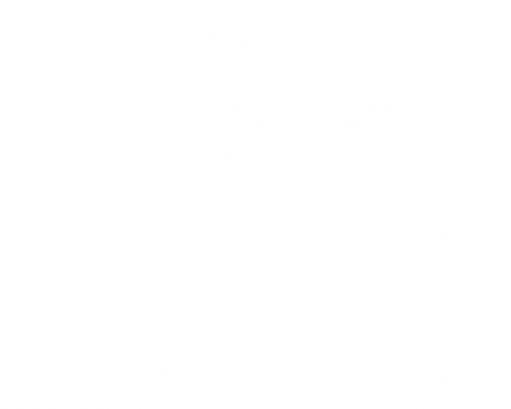
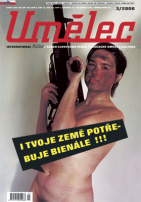



















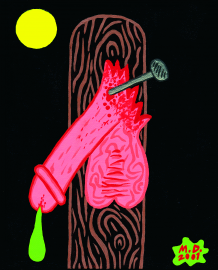





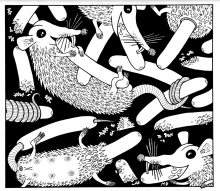
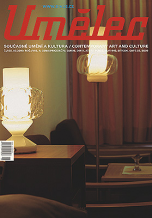
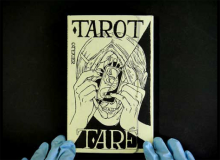


 We Are Rising National Gallery For You! Go to Kyjov by Krásná Lípa no.37.
We Are Rising National Gallery For You! Go to Kyjov by Krásná Lípa no.37.
Комментарии
Статья не была прокомментированаДобавить новый комментарий